How to use students’ everyday experiences to aid understanding in experiments
So why do I have a hip joint, a golf club head and a mini turbine blade out in front of the class today? They’re my hook into the explanation ‘different sized atoms disrupt the lattice structure and prevent the layers from sliding.’ But more than a hook, they are part of my efforts to contextualise the lesson. The 2023 Royal Society science education tracker identified ‘Students were more likely to see science as relevant to wider society than to their everyday life’. This research led me to ask: how do I contextualise practical work so students see how it relates to their own everyday life experiences?
So why do I have a hip joint, a golf club head and a mini turbine blade out in front of the class today? They’re my hook into the explanation ‘different sized atoms disrupt the lattice structure and prevent the layers from sliding.’ But more than a hook, they are part of my efforts to contextualise the lesson. The 2023 Royal Society science education tracker identified ‘Students were more likely to see science as relevant to wider society than to their everyday life’ (pdf: bit.ly/42gtwaY). This research led me to ask: how do I contextualise practical work so students see how it relates to their own everyday life experiences?
Water and purification
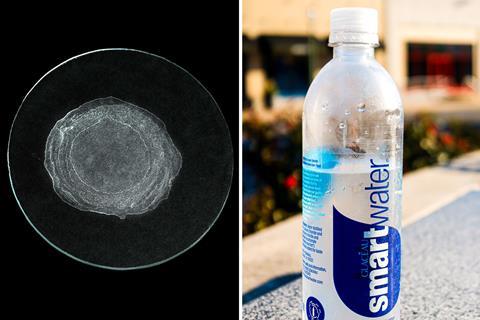
I’ll begin with water, more specifically its place in 14–16 specifications. Thinking creatively about a real-life context, let’s consider bottles of Smartwater learners might see on the shelf in the shop. Smartwater lends itself perfectly to the water purification practical in which students must calculate the mass of dry residue in a sample of water. They need to evaporate to dryness a fixed volume of their water sample in an evaporating basin until it produces a constant mass of dry residue. Smartwater provides a perfect everyday pupil context as it contains added calcium chloride, magnesium chloride and potassium bicarbonate. Because potassium bicarbonate thermally decomposes between 100 and 120 degrees Celsius, using Smartwater for this experiment offers a great opportunity to add some work about errors.
Water, water everywhere
I’ll begin with water, more specifically its place in 14–16 specifications. Thinking creatively about a real-life context, let’s consider bottles of Smartwater learners might see on the shelf in the shop. Smartwater lends itself perfectly to the water purification practical in which students must calculate the mass of dry residue in a sample of water (rsc.li/4bEK1AU). They need to evaporate to dryness a fixed volume of their water sample in an evaporating basin until it produces a constant mass of dry residue. Smartwater provides a perfect everyday pupil context as it contains added calcium chloride, magnesium chloride and potassium bicarbonate. Because potassium bicarbonate thermally decomposes between 100 and 120 degrees Celsius, using Smartwater for this experiment offers a great opportunity to add some work about errors.
Tattoos and chromatography
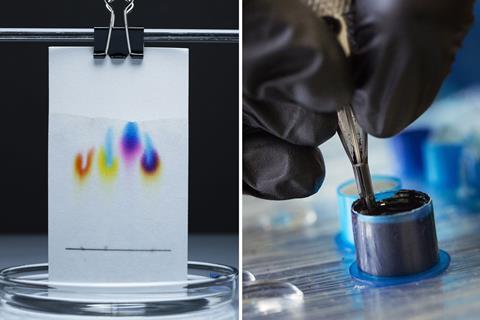
According to a 2022 YouGov poll, 26% of the UK population have a tattoo, so learners are likely to know someone with a tattoo and may already be considering getting one themselves in the future. Research on tattoo inks uncovered 10 that break EU compliance rules, and you can download a summary slide of this research and use it to inject context to lessons on chemical analysis.
Beware of the pitfalls
My experience is that some students remember the context over the content. For example, if you ask your class why we use electrolysis to extract lithium, some will mention the need for phone batteries rather than its position in the reactivity series. You can’t rule out pupils saying flame tests are used to make choices on TV rather than for identifying metals in salts. To mitigate this, I make sure the definitions and applications are a core part of retrieval questions at the start of every lesson. For instance, in the lesson after coffee extraction, I ask pupils to explain how to separate salt from rock salt.
This topic lends itself perfectly to the separation of inks using chromatography. Task learners to work out which tattoo ink you have contaminated using paper chromatography to identify the unsafe inks; check out these five teacher-tested approaches to add colour to your lessons. You could provide pupils with the Rf values of the banned dyes and set it up like a forensics problem where they need to find the ink that has poisoned somebody.
Test some ink
According to a 2022 YouGov poll, 26% of the UK population have a tattoo, so learners are likely to know someone with a tattoo and may already be considering getting one themselves in the future. Research on tattoo inks uncovered 10 that break EU compliance rules, and you can download a summary slide of this research and use it to inject context to lessons on chemical analysis (rsc.li/4ihUncs).
The most frequently used practical for separation techniques is producing salt from rock salt. Why not make coffee instead?
This topic lends itself perfectly to the separation of inks using chromatography (rsc.li/4bAERXd). Task learners to work out which tattoo ink you have contaminated using paper chromatography to identify the unsafe inks; check out these five teacher-tested approaches to add colour to your lessons (rsc.li/42nQtYS). You could provide pupils with the Rf values of the banned dyes and set it up like a forensics problem where they need to find the ink that has poisoned somebody.
Coffee and separation techniques
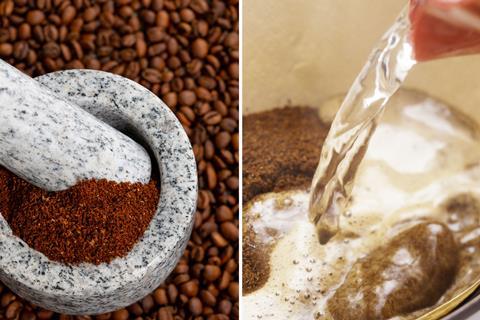
In the UK we drink 98 million cups of coffee per day. Coffee producers use separation techniques, including dissolving, filtration and evaporation. The most frequently used practical for these techniques seems to be producing salt from rock salt. Why not make some coffee instead? Start the lesson with images of different equipment used to make coffee from beans. Grind beans using a mortar and pestle, add hot water, filter and then evaporate the resulting solution over a water bath to cover dissolving, filtration and evaporation in one lesson.
Filter coffee
In the UK we drink 98 million cups of coffee per day. Coffee producers use separation techniques, including dissolving, filtration and evaporation (rsc.li/4kYqDmE). The most frequently used practical for these techniques seems to be producing salt from rock salt. Why not make some coffee instead? Start the lesson with images of different equipment used to make coffee from beans. Grind beans using a mortar and pestle, add hot water, filter and then evaporate the resulting solution over a water bath to cover dissolving, filtration and evaporation in one lesson.
Batteries and reactivity
What is a lithium-ion battery? Have pupils heard of Ni–Cd batteries? What type of battery would they find in a typical smartphone? This is a perfect context for getting pupils to think about the reactivity series by investigating the potential difference produced by different pairings of metal electrodes. Set-up is easy with a voltmeter, ammonium chloride solution in a beaker as an electrolyte and strips of different metals. Pupils record the voltage generated using different pairings of their metals. Explain that an iPhone battery requires 3.7 V: using their results from less reactive materials, can students explain the need for lithium? You can extend this activity and look at how chemists use electrolysis to produce lithium from its molten salts.
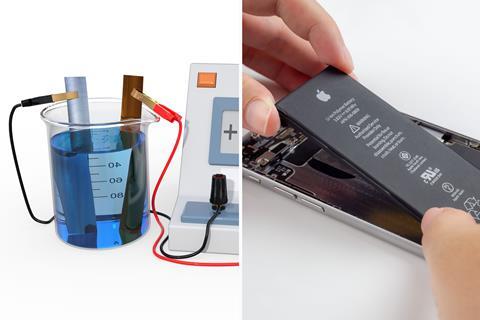
A salt and batteries
What is a lithium-ion battery? Have pupils heard of Ni–Cd batteries? What type of battery would they find in a typical smartphone? This is a perfect context for getting pupils to think about the reactivity series by investigating the potential difference produced by different pairings of metal electrodes. Set-up is easy with a voltmeter, ammonium chloride solution in a beaker as an electrolyte and strips of different metals. Pupils record the voltage generated using different pairings of their metals. Explain that an iPhone battery requires 3.7 V: using their results from less reactive materials, can students explain the need for lithium? You can extend this activity and look at how chemists use electrolysis to produce lithium from its molten salts (rsc.li/3DTeXAV).
Chocolate and melting
Very few pupils don’t like chocolate. But how is it made? A good introduction to this is The Royal Society’s video, with Brian Cox visiting Thornton’s chocolate factory. Following this you could investigate the relationship between cocoa content and melting point by placing foil cake cases, each containing a small piece of chocolate of a different cocoa content, in a tray of hot water. If you have the facilities, have your science lesson in the technology department to try a more adventurous approach: tempering chocolate.
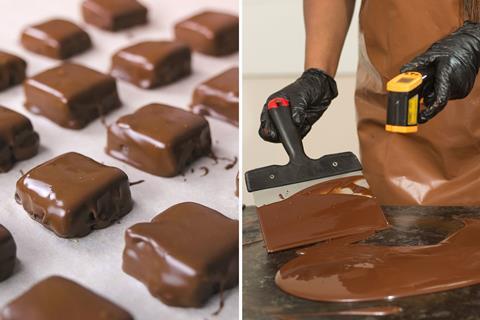
Using a hot water bath you first need to melt the chocolate in a bowl. Gently heat the chocolate to 48 degrees Celsius, then pour two thirds out on to a clean surface and let it cool to 27 degrees Celsius. When cooled, add it back to the bowl and reheat to 32 degrees Celsius. Students can now cool the chocolate in moulds ready for tasting if you’re not in the lab. Next, repeat the start of the experiment but omit the final steps by just pouring all the 48 degrees Celsius chocolate straight into your moulds to cool. When tasting, pupils will notice the different mouthfeel and textures created by changes to the crystal structure of the sugar at different temperatures.
Melty chocolate
Very few pupils don’t like chocolate. But how is it made? A good introduction to this is The Royal Society’s video, with Brian Cox visiting Thornton’s chocolate factory (bit.ly/42eXzjp). Following this you could investigate the relationship between cocoa content and melting point by placing foil cake cases, each containing a small piece of chocolate of a different cocoa content, in a tray of hot water. If you have the facilities, have your science lesson in the technology department to try a more adventurous approach: tempering chocolate (rsc.li/3DLm3HL).
Using a hot water bath you first need to melt the chocolate in a bowl. Gently heat the chocolate to 48 degrees Celsius, then pour two thirds out on to a clean surface and let it cool to 27 degrees Celsius. When cooled, add it back to the bowl and reheat to 32 degrees Celsius. Students can now cool the chocolate in moulds ready for tasting if you’re not in the lab. Next, repeat the start of the experiment but omit the final steps by just pouring all the 48 degrees Celsius chocolate straight into your moulds to cool. When tasting, pupils will notice the different mouthfeel and textures created by changes to the crystal structure of the sugar at different temperatures.
The Traitors and flame tests
A recent example of chemistry popping up in people’s day-to-day lives has been the BBC series The Traitors. Contestants choose pouches they throw into a firepit and that burn with either a green or red flame. Which metal salts did the show use to do this? Demonstrate by making tiny paper parcels filled with metal salts and dropping them on to a gauze over a Bunsen burner. Get students to test the flame colours of different salts to determine what’s in the pouches. To extend this, ask pupils to investigate the ideal salt to produce a new distinctive colour for a third choice. You could conclude this lesson with the flaming rainbow demonstration for its dramatic effect.
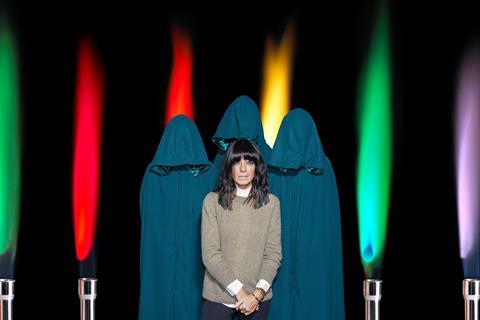
A recent example of chemistry popping up in people’s day-to-day lives has been the BBC series The Traitors. Contestants choose pouches they throw into a firepit and that burn with either a green or red flame. Which metal salts did the show use to do this? Demonstrate by making tiny paper parcels filled with metal salts and dropping them on to a gauze over a Bunsen burner. Get students to test the flame colours of different salts to determine what’s in the pouches (rsc.li/4kyMy3F). To extend this, ask pupils to investigate the ideal salt to produce a new distinctive colour for a third choice. You could conclude this lesson with the flaming rainbow demonstration for its dramatic effect (rsc.li/4izrTe0).
Beware of the pitfalls
My experience is that some students remember the context over the content. For example, if you ask your class why we use electrolysis to extract lithium, some will mention the need for phone batteries rather than its position in the reactivity series. You can’t rule out pupils saying flame tests are used to make choices on TV rather than for identifying metals in salts. To mitigate this, I make sure the definitions and applications are a core part of retrieval questions at the start of every lesson. For instance, in the lesson after coffee extraction, I ask pupils to explain how to separate salt from rock salt.
There are many other contexts to introduce in your lessons: why not try firework colours and flame tests, texture and melting points in lipsticks, or self-heating camping foods when studying exothermic reactions?
More contexts
You will find the examples from this article, and more, for the experiments in our 14–16 core practical videos.
Ian McDaid Ian is a STEM leader in a large secondary school

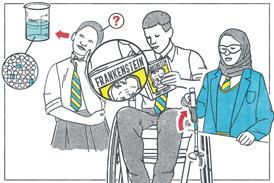

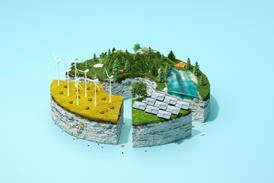

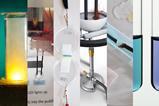

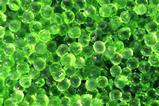






2 readers' comments